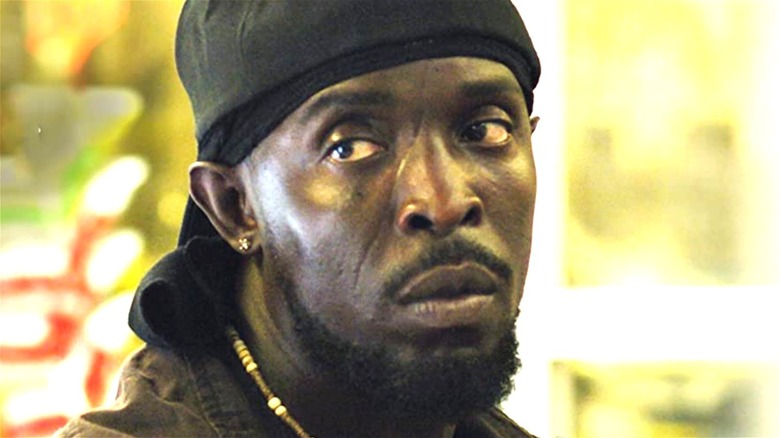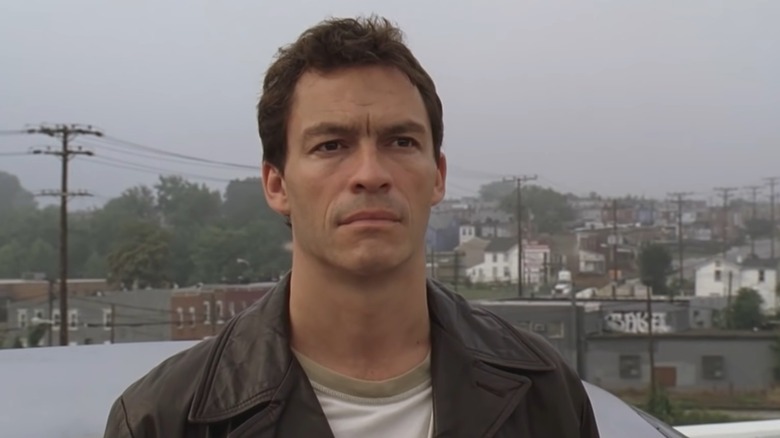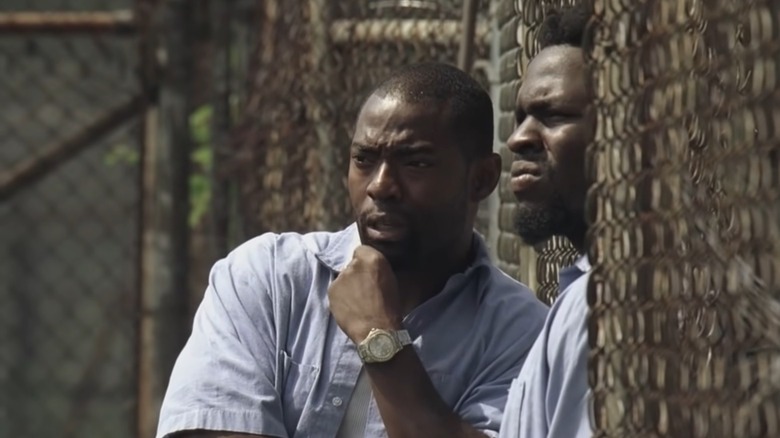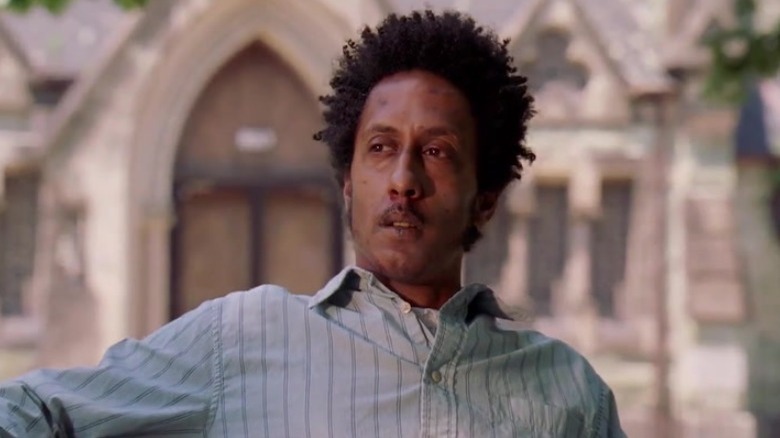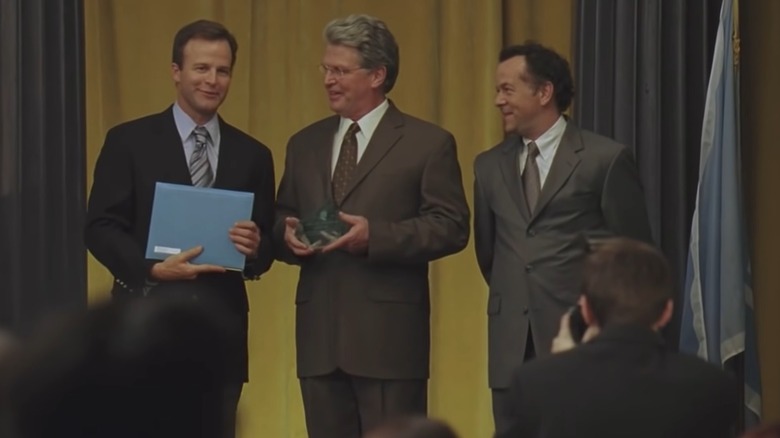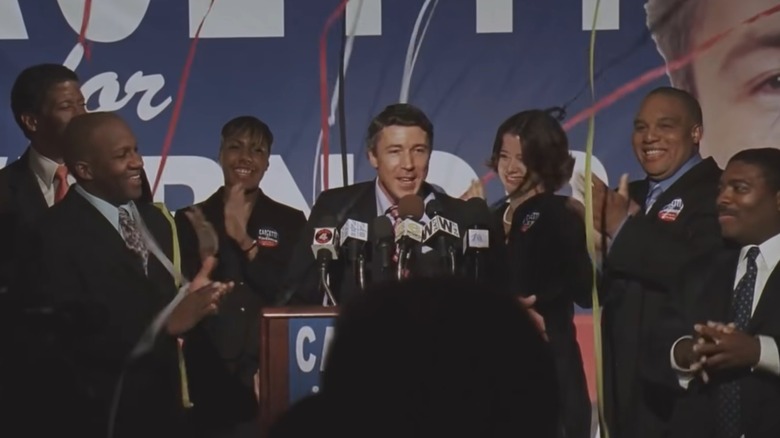The Ending Of The Wire Explained
While "The Wire" never reached the same level of pop-culture saturation that HBO's other major prestige program from the same era, "The Sopranos," the Baltimore crime drama still holds a special place in fans' hearts. The series ranks among the most perfect TV shows ever made, and both programs helped define the HBO of the early 2000s as the home for deliberate, thoughtful television that tackled complex themes.
One of the most interesting choices that "The Wire" made was to focus on a different aspect of life in Baltimore in each season. This wasn't quite an anthology-style structure that's seen in "American Horror Story," as each subsequent season would continue the story of some of the characters introduced in previous seasons. Exploring seemingly unrelated systems, such as dockworkers unions and public schools, gave viewers a better understanding of the interconnected nature of the city's dysfunctional institutions.
However, the branching storytelling featured in "The Wire" meant that the show had a lot of loose ends to resolve. Considering just how much is going on by Season 5's final episode, the finale, "-30-," does a pretty thorough job of wrapping it all up, but there's a lot happening. Here is the ending of "The Wire" explained.
The Baltimore Police Department loses some good men
"The Wire" opened its first season by highlighting the Baltimore Police Department and the war it waged with a criminal empire of drug dealers. Viewers met some of the characters on "The Wire" who would be present in one form or another throughout the entire show, such as Jimmy McNulty (Dominic West), Lester Freaman (Clarke Peters), and Lt. Daniels (Lance Reddick).
By the end of "The Wire," none of those characters remain employed by the Baltimore Police Department. One of the core plotlines of the final season was Jimmy and Lester's falsification of murder investigations to lead the public to believe that a serial killer was on the loose, with the idea that doing so would give them access to extra resources to take down drug kingpin Marlo (Jamie Hector). When their deception is revealed, the consequences are swift.
Jimmy and Lester are both offered a quiet retirement to try and keep the issue out of the press. Lt. Daniels receives a promotion to commissioner, both for the success of his unit in stopping the "serial killer," which is pinned on a homeless man who admits two copycat murders. However, he soon resigns after refusing to falsify statistics to make Mayor Carcetti (Aidan Gillen) look better.
However, the ending of the often unforgiving drama is surprisingly kind to the ex-cops. Daniels presents a case in court as a lawyer, the career he promised his wife he would return to in Season 2. Viewers see Freaman building his miniature furniture with Shardene (Wendy Grantham), the stripper he befriended in Season 1. Finally, a now sober McNulty seems to find peace, leaving his pretend wake early to return to the comfortable domesticity he has established with Beadie (Amy Ryan), the port authority officer he met in Season 2.
The violence on the streets of Baltimore rolls into the next generation
Opposite the police department, the other constants in "The Wire" are the criminal organizations that control the streets and command the city's trade in illicit substances. The deadly environment of that business means many of the characters from that corner of "The Wire," such as Stringer Bell (Idris Elba) and Omar (Michael K. Williams), are gone by the time the credits roll on the final episode.
However, "The Wire" is a show that rewards viewers who look for patterns, and remnants of those two legendary characters can be seen in some of the final moments. For instance, Omar, who came to a relatively inglorious death at the hands of a young boy a few episodes prior, is evoked in one of the show's final scenes when Michael Lee (Tristan Wilds) robs a stash house. Michael wields a shotgun, just as Omar did, and shoots one of his victims in the leg, an almost beat-for-beat imitation of the audience's first encounter with legendary Robin Hood of the streets in Season 1.
Likewise, even the long-gone Stringer Bell, who died at Omar's hands in Season 3, is evoked in the ending of "The Wire." After Marlo's lawyer Levy (Michael Kostroff) gets the kingpin out of prison without facing criminal charges on the condition that he retires from the drug trade permanently, he takes him to a fancy cocktail party to meet potential business partners. Stringer Bell's greatest ambition, of course, was to convert a criminal business empire into a legitimate one, and the ending of "The Wire" makes it seem like Marlo might be on the cusp of achieving that goal.
Marginalized individuals find highs and lows in The Wire
Another example of the ending of "The Wire" proving its point with repetition is in its handling of two of its most tragic characters, Bubbles (Andre Royo) and Dukie (Jermaine Crawford).
Bubbles and his friend Johnny (Leo Fitzpatrick) gave the audience a look into the toll heroin use has on individuals. In the first episode of "The Wire," Johnny is brutally beaten for passing counterfeit money to Wallace (Michael B. Jordan), and his death in Season 3 sent Bubbles spiraling back into addiction. However, in the final season of "The Wire," Bubbles seems to have found a stable place in life. He lands employment selling newspapers, shares his story with The Baltimore Sun, and is active in Narcotics Anonymous. When the final montage rolls, he is even invited upstairs in his sister's home, something that was strictly forbidden ever since he originally received permission to stay in the basement in Season 1, setting up one of the best character endings on "The Wire."
Bubbles' success is contrasted with Dukie's descent into a life much like the one Bubbles lived. Viewers see Dukie, a major focus of Season 4's examination of public schools, visit Mr. Pryzbylewski (Jim True-Frost), the unskilled cop who finally redeemed himself as a competent teacher. Dukie asks Pryzbylewski for money to help him get his GED, but when Pryzbylewski investigates, he observes that Dukie is using the money to buy drugs.
During the final montage, Bubbles' sobriety is contrasted with Dukie's descent into addiction. Viewers see the teenager use with Bubbles' old partner in copper theft, the Junk Man (Keith Moyer), at the end of what some fans on Reddit called the series' most heartbreaking story arc.
The Baltimore Sun is rewarded for unethical journalism
While Season 5 of "The Wire" masterfully balances the many elements the show has introduced over the entire series, it too has a unique focus. That center point is print journalism, and much of the action revolves around The Baltimore Sun's reporting on the fake serial killer that detectives McNulty and Freaman invented to gain increased funding.
One of the key figures in The Baltimore Sun storyline is Scott Templeton (Tom McCarthy), an ambitious reporter who wants to use his time in Baltimore to propel himself to a paper of larger renown, such as The Washington Post or The New York Times. To do that, he needs to land a massive story, something that would raise his national profile and maybe even net him a prestigious prize, such as a Pulitzer.
He finds that story in the fake serial killer. When the trail goes cold, which occurs as soon as McNulty and Freaman stop inventing evidence for it, Templeton becomes more aggressive about fabricating material to keep the story alive. However, his reporting, and the newspapers it is helping to sell, are supported by senior editors at The Baltimore Sun. The only person in the newsroom who seriously challenges the integrity of Templeton's reporting is Gus Haynes (Clark Johnson). When Haynes raises his suspicions, the managing editors demote him from the city desk to the copy desk.
In the final moments of "The Wire," we see Templeton and the editors who enabled him receive the prize they desired. Once again, the show reinforces that institutional dysfunction rewards those who often don't deserve it. However, this time, that notion is underlined by the fact that one of the institutions dedicated to finding and exposing those dysfunctions, the media, can itself easily suffer from critical dysfunction.
Life in the city of Baltimore goes on, for better or for worse
The final montage of "The Wire ” serves as something of an epilogue for the show. By paying close attention, viewers can find clues about what the future holds for Baltimore and its people.
That montage shows the political prospects of some of the characters the show focused on in Season 3, which revolved around the Baltimore government. For instance, Tommy Carcetti, the idealistic city council member who became increasingly corrupt as he gained influence and became mayor, is shown celebrating another successful election night, this time as governor of Maryland. Carcetti's new position is confirmed when city council president Campbell (Marlyne Afflack) takes his old job as mayor and when he swears in Commissioner Rawls (John Doman) as the superintendent of the Maryland State Police.
Viewers also briefly see the fates of characters long removed from primary storylines. The Greek (Bill Raymond), who was the impetus for much of the unfortunate action at the docks in the near-perfect Season 2, is shown observing a meeting with Slim Charles (Anwan Glover), who, just a few scenes before, ended Cheese's (Method Man) bid for control. In addition, Wee-Bey (Hassan Johnson) is seen serving his life sentence in prison, accompanied by Chris Parlow (Gbenga Akinnagbe).
While fans see many familiar faces in that montage, they also observe many unfamiliar individuals. These are shots of actual citizens of Baltimore (via Vulture). As the footage cuts from locations fans know and places they likely don't, the ending of "The Wire ” gives the impression that life in the city will continue, despite the hardships its people endure due to unfair and dysfunctional institutions. For a program that dove deep into the most challenging aspects of life in urban America, it's a hopeful note to end on.
